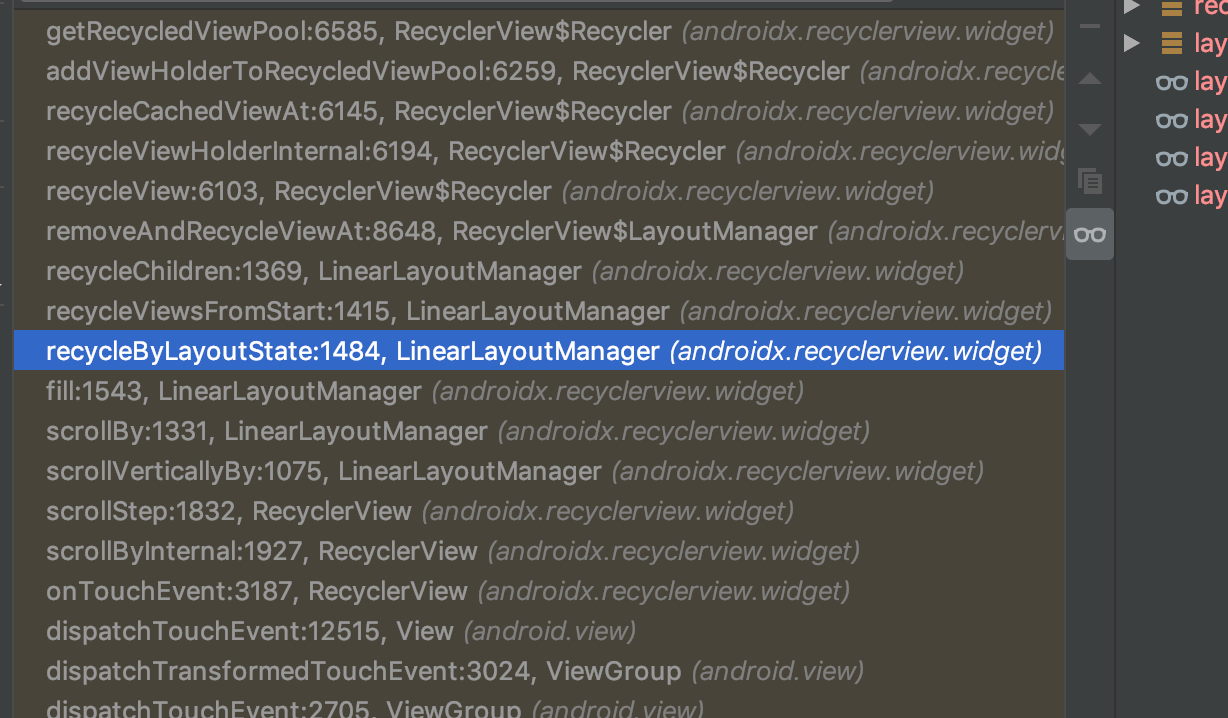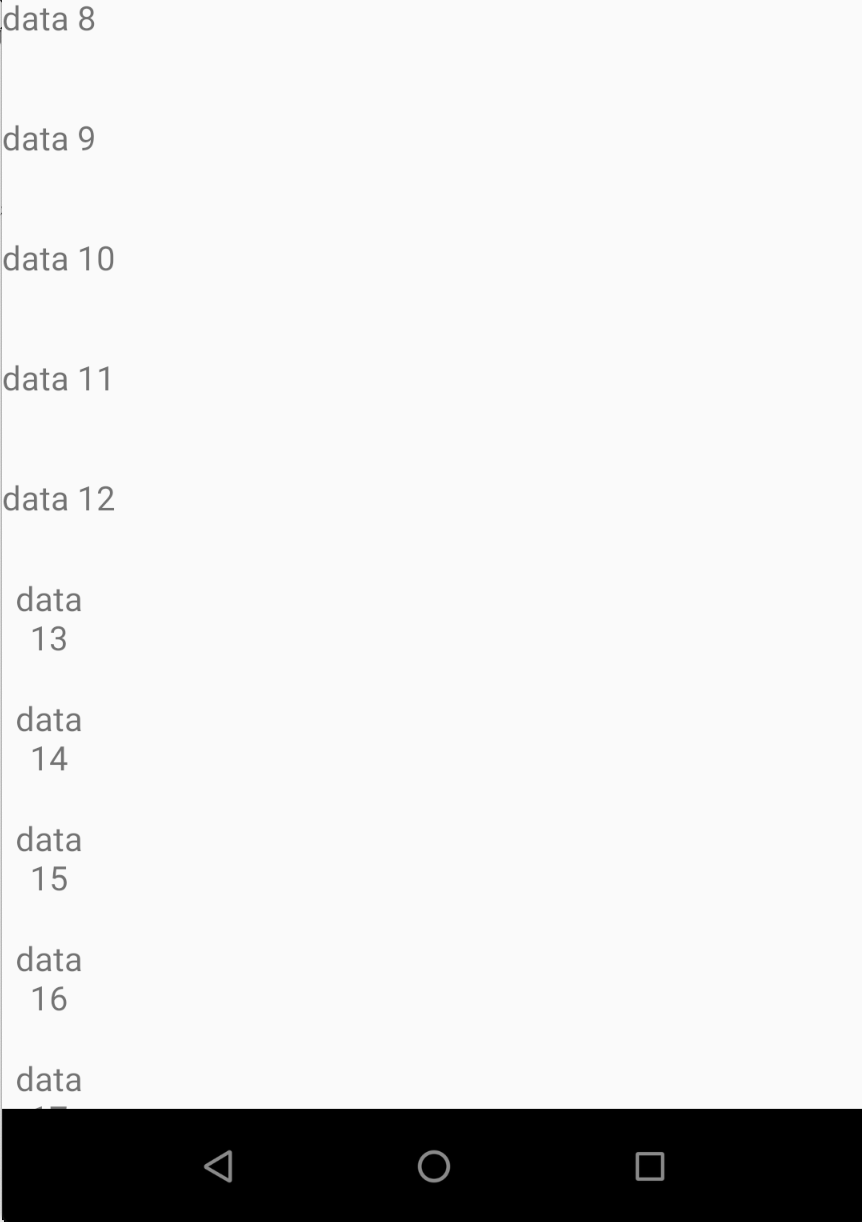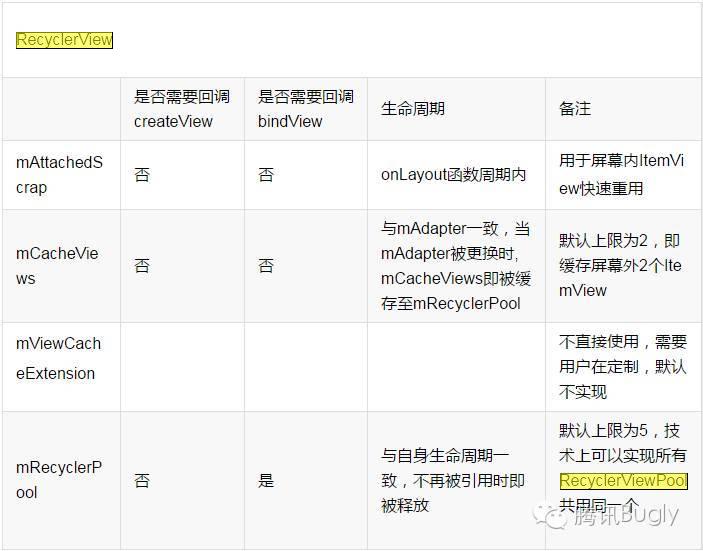上一节分析了 RecyclerView 的绘制流程,本节我们分析下 RecyclerView 的缓存机制。(本文基于 LinearLayoutManager)
源码分析
上一节中在 LayoutManager 中我们提到过在 layoutChunk 中的 View view = layoutState.next(recycler); 执行了 itemView 的复用或创建,我们从这里开始看。
View next(RecyclerView.Recycler recycler) {
if (mScrapList != null) {
return nextViewFromScrapList();
}
final View view = recycler.getViewForPosition(mCurrentPosition);
mCurrentPosition += mItemDirection;
return view;
}
在这里首先有一个判断,如果 mScrapList 不为 null 首先从 mScrapList 获取。先看一下 mScrapList:
/**
* When LLM needs to layout particular views, it sets this list in which case, LayoutState
* will only return views from this list and return null if it cannot find an item.
*/
List<RecyclerView.ViewHolder> mScrapList = null;
private void layoutForPredictiveAnimations(RecyclerView.Recycler recycler,
RecyclerView.State state, int startOffset,
int endOffset) {
...
final List<RecyclerView.ViewHolder> scrapList = recycler.getScrapList();
...
mLayoutState.mScrapList = scrapList;
...
}
它是在 layoutForPredictiveAnimations 中被赋值的,这里又指向了 Recycler 的 mUnmodifiableAttachedScrap :
private final List<ViewHolder>
mUnmodifiableAttachedScrap = Collections.unmodifiableList(mAttachedScrap);
有人说 「scrapList 是 RecyclerView 的第五级缓存」,但是这里又指向了 Recycler 中我们接下来要分析的缓存 mAttachedScrap。 这么做的目的是什么?我们先记住这个问题,以后有机会再分析。
再回到 next() 方法,接着往下走:
public View getViewForPosition(int position) {
return getViewForPosition(position, false);
}
View getViewForPosition(int position, boolean dryRun) {
return tryGetViewHolderForPositionByDeadline(position, dryRun, FOREVER_NS).itemView;
}
经过两个中间方法之后,最终走到了 tryGetViewHolderForPositionByDeadline 这也是我们今天分析的重点之一。
ViewHolder tryGetViewHolderForPositionByDeadline(int position,
boolean dryRun, long deadlineNs) {
...
ViewHolder holder = null;
// 0) 如果有变动缓存,从变动缓存里获取
if (mState.isPreLayout()) {
holder = getChangedScrapViewForPosition(position);
fromScrapOrHiddenOrCache = holder != null;
}
// 1) 根据 position 从 scrap/hidden list/cache 中获取
if (holder == null) {
holder = getScrapOrHiddenOrCachedHolderForPosition(position, dryRun);
...
}
if (holder == null) {
final int type = mAdapter.getItemViewType(offsetPosition);
// 2) 如果 adapter 复写了 stableIds ,根据 stableId 从 scrap 中获取
if (mAdapter.hasStableIds()) {
holder = getScrapOrCachedViewForId(mAdapter.getItemId(offsetPosition),
type, dryRun);
if (holder != null) {
// update position
holder.mPosition = offsetPosition;
fromScrapOrHiddenOrCache = true;
}
}
if (holder == null && mViewCacheExtension != null) {
// 从 mViewCacheExtension 中获取,这个要自己实现
final View view = mViewCacheExtension
.getViewForPositionAndType(this, position, type);
...
}
if (holder == null) { // fallback to pool
...
// 从 RecyclerViewPool 中获取
holder = getRecycledViewPool().getRecycledView(type);
if (holder != null) {
holder.resetInternal();
if (FORCE_INVALIDATE_DISPLAY_LIST) {
invalidateDisplayListInt(holder);
}
}
}
if (holder == null) {
...
// 创建 ViewHolder
holder = mAdapter.createViewHolder(RecyclerView.this, type);
...
}
}
...
boolean bound = false;
if (mState.isPreLayout() && holder.isBound()) {
// do not update unless we absolutely have to.
holder.mPreLayoutPosition = position;
} else if (!holder.isBound() || holder.needsUpdate() || holder.isInvalid()) {
if (DEBUG && holder.isRemoved()) {
throw new IllegalStateException("Removed holder should be bound and it should"
+ " come here only in pre-layout. Holder: " + holder
+ exceptionLabel());
}
final int offsetPosition = mAdapterHelper.findPositionOffset(position);
// 绑定数据
bound = tryBindViewHolderByDeadline(holder, offsetPosition, position, deadlineNs);
}
...
return holder;
}
以上代码做了一些删减,列出了关键步骤并添加了一些注释,下面我们一步步来分析它。
// 0) 如果有变动缓存,从变动缓存里获取
if (mState.isPreLayout()) {
holder = getChangedScrapViewForPosition(position);
fromScrapOrHiddenOrCache = holder != null;
}
这里跟动画或数据变动有关? 我们先跳过这段等分析动画或数据更新的时候再来看它。继续往下看:
// 1) 根据 position 从 scrap/hidden list/cache 中获取
if (holder == null) {
holder = getScrapOrHiddenOrCachedHolderForPosition(position, dryRun);
...
}
这里调用了另一个方法,继续。
ViewHolder getScrapOrHiddenOrCachedHolderForPosition(int position, boolean dryRun) {
final int scrapCount = mAttachedScrap.size();
// Try first for an exact, non-invalid match from scrap.
for (int i = 0; i < scrapCount; i++) {
final ViewHolder holder = mAttachedScrap.get(i);
if (!holder.wasReturnedFromScrap() && holder.getLayoutPosition() == position
&& !holder.isInvalid() && (mState.mInPreLayout || !holder.isRemoved())) {
holder.addFlags(ViewHolder.FLAG_RETURNED_FROM_SCRAP);
return holder;
}
}
if (!dryRun) {
View view = mChildHelper.findHiddenNonRemovedView(position);
if (view != null) {
// 找到隐藏的 view 先 detach 然后复用
final ViewHolder vh = getChildViewHolderInt(view);
mChildHelper.unhide(view);
int layoutIndex = mChildHelper.indexOfChild(view);
if (layoutIndex == RecyclerView.NO_POSITION) {
throw new IllegalStateException("layout index should not be -1 after "
+ "unhiding a view:" + vh + exceptionLabel());
}
mChildHelper.detachViewFromParent(layoutIndex);
scrapView(view);
vh.addFlags(ViewHolder.FLAG_RETURNED_FROM_SCRAP
| ViewHolder.FLAG_BOUNCED_FROM_HIDDEN_LIST);
return vh;
}
}
// Search in our first-level recycled view cache.
final int cacheSize = mCachedViews.size();
for (int i = 0; i < cacheSize; i++) {
final ViewHolder holder = mCachedViews.get(i);
// invalid view holders may be in cache if adapter has stable ids as they can be
// retrieved via getScrapOrCachedViewForId
if (!holder.isInvalid() && holder.getLayoutPosition() == position) {
if (!dryRun) {
mCachedViews.remove(i);
}
if (DEBUG) {
Log.d(TAG, "getScrapOrHiddenOrCachedHolderForPosition(" + position
+ ") found match in cache: " + holder);
}
return holder;
}
}
return null;
}
mAttachedScrap
首先第一步是从 mAttachedScrap 中获取,这里要先区分两个概念 detach 和 remove:
detach: 在 ViewGroup 中的实现很简单,只是将 ChildView 从 ParentView 中 ChildView 数组中移除,ChildView 的 parent 设置为 null,可以理解为轻量级的 remove。View 被 detach 一般是临时的,随后可以再 attach。 remove: 真正的移除,不光从 ChildView 数组中移除,和 View 树的各项联系也被切断。
在 RecyclerView 的高度被设置为 wrap_content 的时候,RecyclerView 会经历两次 measure 和 layout,在第二次的时候第一次创建的 ViewHolder 会首先被 detach 然后再 attach 这时 mAttachedScrap 就起了作用。
其实高度设置为 match_parent 或 固定高度也会经历两次 measure,只是测量模式为 EXACTLY,onMeasure 中直接返回了。在高度为 wrap_content 的时候首先用 ItemView 填充以 measure RecyclerView 的高度,第二次的时候 View 直接就可以复用。
mAttachedScrap 获取的 ViewHolder 已经被绑定过数据,不需要重新绑定。
为什么 RecyclerView 会经历两次 measure 和 layout? 好吧,又挖了一个坑,感觉坑越来越多。
mCachedViews
接下来是隐藏的 ItemView 先 detach 然后再复用,这里就不详细解释了。继续往下是 mCachedViews,代码如下:
// Search in our first-level recycled view cache.
final int cacheSize = mCachedViews.size();
for (int i = 0; i < cacheSize; i++) {
final ViewHolder holder = mCachedViews.get(i);
// invalid view holders may be in cache if adapter has stable ids as they can be
// retrieved via getScrapOrCachedViewForId
if (!holder.isInvalid() && holder.getLayoutPosition() == position) {
if (!dryRun) {
mCachedViews.remove(i);
}
if (DEBUG) {
Log.d(TAG, "getScrapOrHiddenOrCachedHolderForPosition(" + position
+ ") found match in cache: " + holder);
}
return holder;
}
}
return null;
mCachedViews 是 Recycler 中的一个 ArrayList,它的默认大小是 2。如果存储的数据量大于二,会将最老的 View 移到 RecyclerPool 中。 上面这段代码中,holder 是有效的并且 holder 的 position 和目标 position 一直才会复用,所以它也不需要重新 bind。
经过这两步之后又回到了 tryGetViewHolderForPositionByDeadline,我们接着往下看: mAdapter.hasStableIds 这个要在 Adapter 中复写相关方法,我们先跳过。
接下来是 mViewCacheExtension ,这个同样要我们自己实现。 再继续往下,分别是 RecyclerViewPool 和 createViewHolder。
RecyclerViewPool
我们先看一下 RecyclerViewPool 的关键属性和方法,不是很难就不一一解释了。
public static class RecycledViewPool {
private static final int DEFAULT_MAX_SCRAP = 5;
static class ScrapData {
final ArrayList<ViewHolder> mScrapHeap = new ArrayList<>();
int mMaxScrap = DEFAULT_MAX_SCRAP;
long mCreateRunningAverageNs = 0;
long mBindRunningAverageNs = 0;
}
SparseArray<ScrapData> mScrap = new SparseArray<>();
private int mAttachCount = 0;
@Nullable
public ViewHolder getRecycledView(int viewType) {
final ScrapData scrapData = mScrap.get(viewType);
if (scrapData != null && !scrapData.mScrapHeap.isEmpty()) {
final ArrayList<ViewHolder> scrapHeap = scrapData.mScrapHeap;
return scrapHeap.remove(scrapHeap.size() - 1);
}
return null;
}
}
不过需要注意的是,从 RecyclerViewPool 中获取的 ViewHolder,数据会被重置,也就是说它需要重新绑定数据。
if (holder != null) {
holder.resetInternal();
if (FORCE_INVALIDATE_DISPLAY_LIST) {
invalidateDisplayListInt(holder);
}
}
void resetInternal() {
mFlags = 0;
mPosition = NO_POSITION;
mOldPosition = NO_POSITION;
mItemId = NO_ID;
mPreLayoutPosition = NO_POSITION;
mIsRecyclableCount = 0;
mShadowedHolder = null;
mShadowingHolder = null;
clearPayload();
mWasImportantForAccessibilityBeforeHidden = ViewCompat.IMPORTANT_FOR_ACCESSIBILITY_AUTO;
mPendingAccessibilityState = PENDING_ACCESSIBILITY_STATE_NOT_SET;
clearNestedRecyclerViewIfNotNested(this);
}
再往下如果还没有找到可用的 ViewHolder,就只能调用 Adapter 重新创建了,方法我们都很熟悉,就不看了。
上面只是 ViewHolder 的创建和复用流程,那么 ViewHolder 是怎么被回收的呢?我们再看一遍回收流程。
@Override
public boolean onTouchEvent(MotionEvent e) {
...
switch (action) {
...
case MotionEvent.ACTION_MOVE: {
...
if (mScrollState == SCROLL_STATE_DRAGGING) {
mLastTouchX = x - mScrollOffset[0];
mLastTouchY = y - mScrollOffset[1];
// 1
if (scrollByInternal(
canScrollHorizontally ? dx : 0,
canScrollVertically ? dy : 0,
vtev)) {
getParent().requestDisallowInterceptTouchEvent(true);
}
//2
if (mGapWorker != null && (dx != 0 || dy != 0)) {
mGapWorker.postFromTraversal(this, dx, dy);
}
}
} break;
...
return true;
}
View 复用要从滑动说起,也就是上面的 onTouchEvent,关键节点有两个,我们一个个来看。
方法路径如下:

我就不一个一个看了,直接从 Recycler.recycleView 开始。
public void recycleView(@NonNull View view) {
// This public recycle method tries to make view recycle-able since layout manager
// intended to recycle this view (e.g. even if it is in scrap or change cache)
ViewHolder holder = getChildViewHolderInt(view);
if (holder.isTmpDetached()) {
removeDetachedView(view, false);
}
if (holder.isScrap()) {
holder.unScrap();
} else if (holder.wasReturnedFromScrap()) {
holder.clearReturnedFromScrapFlag();
}
recycleViewHolderInternal(holder);
}
recycleViewHolderInternal
void recycleViewHolderInternal(ViewHolder holder) {
...
boolean cached = false;
boolean recycled = false;
...
if (forceRecycle || holder.isRecyclable()) {
if (mViewCacheMax > 0
&& !holder.hasAnyOfTheFlags(ViewHolder.FLAG_INVALID
| ViewHolder.FLAG_REMOVED
| ViewHolder.FLAG_UPDATE
| ViewHolder.FLAG_ADAPTER_POSITION_UNKNOWN)) {
// Retire oldest cached view
// 如果 mCachedViews 已经满了,将最老的移到 RecyclerViewPool
int cachedViewSize = mCachedViews.size();
if (cachedViewSize >= mViewCacheMax && cachedViewSize > 0) {
recycleCachedViewAt(0);
cachedViewSize--;
}
int targetCacheIndex = cachedViewSize;
if (ALLOW_THREAD_GAP_WORK
&& cachedViewSize > 0
&& !mPrefetchRegistry.lastPrefetchIncludedPosition(holder.mPosition)) {
// when adding the view, skip past most recently prefetched views
int cacheIndex = cachedViewSize - 1;
while (cacheIndex >= 0) {
int cachedPos = mCachedViews.get(cacheIndex).mPosition;
if (!mPrefetchRegistry.lastPrefetchIncludedPosition(cachedPos)) {
break;
}
cacheIndex--;
}
targetCacheIndex = cacheIndex + 1;
}
// 将目标添加到 mCachedViews
mCachedViews.add(targetCacheIndex, holder);
cached = true;
}
if (!cached) {
// 如果上面没有成功 添加到 RecyclerViewPool 中
addViewHolderToRecycledViewPool(holder, true);
recycled = true;
}
} else {
...
}
这里我们可以看到:
mCachedViews 优先级比 RecyclerViewPool 高,如果 mCachedViews 已满,将最老的那个放到 RecyclerViewPool 中,可以理解为一个先进先出的队列。
让我们再回到 onTouchEvent,看另一个可能触发 ViewHolder 生成与缓存的方法:
if (mGapWorker != null && (dx != 0 || dy != 0)) {
mGapWorker.postFromTraversal(this, dx, dy);
}
void postFromTraversal(RecyclerView recyclerView, int prefetchDx, int prefetchDy) {
if (recyclerView.isAttachedToWindow()) {
if (RecyclerView.DEBUG && !mRecyclerViews.contains(recyclerView)) {
throw new IllegalStateException("attempting to post unregistered view!");
}
if (mPostTimeNs == 0) {
mPostTimeNs = recyclerView.getNanoTime();
recyclerView.post(this);
}
}
recyclerView.mPrefetchRegistry.setPrefetchVector(prefetchDx, prefetchDy);
}
recyclerView.post(this); 这个方法我们都很熟悉,它是什么意思呢?其实就是向 Handler 发送一个消息,然后等待执行。
但是在 RecyclerView 向上滑动的时候必定会触发 ItemView 的 invalidate,这个时候会向 Handler 消息队列中插入一个同步屏障:
void scheduleTraversals() {
if (!mTraversalScheduled) {
mTraversalScheduled = true;
mTraversalBarrier = mHandler.getLooper().getQueue().postSyncBarrier();
mChoreographer.postCallback(
Choreographer.CALLBACK_TRAVERSAL, mTraversalRunnable, null);
if (!mUnbufferedInputDispatch) {
scheduleConsumeBatchedInput();
}
notifyRendererOfFramePending();
pokeDrawLockIfNeeded();
}
}
所以 RecyclerView.post 向主线程发送的消息会在停止滑动之后再执行。


上图中,图一中 item 17 已经有部分显示,这时候滑动停止。然后之前发送的回掉触发了 item 18 的生成与回收。新生成的 item 被放到 mCachedViews 里。
也就是说 mCachedViews 存储的不只是被回收的 ViewHolder 还有可能是即将显示而被提前创建出来的 item。
以上,RecyclerView 的缓存机制已经分析完了。
总结
直接放网上的一个图吧

不过有一点需要注意,mCacheView 的 size() 并不是一直都是 2。GapWorker 有可能将它更新为 3.